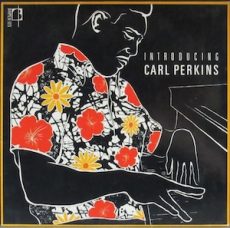
Requisites
Introducing Carl Perkins ~ Carl Perkins | By Eddie Carter
One of my favorite things to do after a long day is listening to a piano trio album when reading. I first heard Carl Perkins on Harold In The Land of Jazz and You Get More Bounce With Curtis Counce. Introducing Carl Perkins (Dootone Records DL-211) is a 1956 release and his only album as a leader. He began playing professionally with Tiny Bradshaw and Big Jay McNeely in the late forties, then became a unique talent in the fifties. Despite polio afflicting his left arm, he developed a piano technique that was all his own. Leroy Vinnegar joins him on bass, and Lawrence Marable on drums completes the trio. My copy is the 1984 U.K. Mono reissue (Boplicity Records BOP-8).
Side One opens with Way Cross Town, the first of five Carl Perkins originals. The melody’s opening notes give the song a lively bounce. Carl is up first and delivers the lead solo with great spirit. Leroy takes a nice leisurely walk next, and then Lawrence has a short conversation with the pianist ahead of the closing chorus and abrupt stop. You Don’t Know What Love Is by Gene de Paul and Don Raye begins with a lovely solo introduction by Perkins, segueing into the trio’s pretty melody. Carl performs beautifully and sincerely as the song’s only soloist, culminating with a gentle theme reprise and climax.
The Lady Is a Tramp by Richard Rodgers and Lorenz Hart moves the beat to mid-tempo for the trio’s opening chorus. The mood is joyous from the start of the threesome’s theme. Carl delivers the song’s only interpretation with a carefree zest, leading to the theme’s restatement and close. Marblehead by Carl Perkins begins with the trio taking it easy on the opening ensemble. The pianist steps into the spotlight first to dispense a little home cooking. Vinnegar takes his bass for a short walk next, then Perkins returns to make a final comment preceding the ensemble’s theme restatement and ending.
Woody ‘n’ You by Dizzy Gillespie is among his most ageless compositions. The trio begins the jazz standard with a relaxing Latin-flavored melody. Carl has the solo showcase alone and keeps close to the bluesy spirit as his interpretation unfolds, while the rhythm section perfectly complements him into the ending theme and fade-out. Westside by Carl Perkins is a happy little tune that gets underway with the trio’s cheerful theme. The pianist is up first with an attractive reading, and then Vinnegar comes in for a buoyant walk. Marable applies a marvelous touch to the closer before the trio’s out-chorus.
Side Two starts with Just Friends by John Klemmer and Sam M. Lewis. Lawrence introduces the song with a short introduction that segues into the trio’s joyful melody. Carl leads the way and works his magic in the opening solo, then engages in a brief conversation with the drummer, leading to the closing ensemble. It Could Happen To You by Jimmy Van Heusen, and Johnny Burke is a beautiful song from the forties. Perkins’s lovely introduction sets the mood for the trio, showing its sentimental side in a tender melody. The pianist delivers the only solo with great sensitivity and delicacy ahead of the group’s gorgeous finale.
Why Do I Care by Carl Perkins is a much happier song than its title suggests, as exhibited in the trio’s medium groove on the theme. Carl takes the lead and constructs the opening solo effectively. Leroy comes in next to take a short walk, and Leroy returns for the theme’s reprise and close. Lilies In The Rain by Peter DeRose and Mitchell Parish is a lovely ballad that begins with an unaccompanied piano introduction to the trio’s gorgeous melody. In the song’s only solo, Perkins presents a thoughtfully tender presentation matched by the rhythm section’s elegant support until the trio’s return for a gentle ending.
It’s finger-popping time for the album’s final track, Carl’s Blues by Carl Perkins. The trio sets the scene with their easygoing opening chorus. The pianist approaches the first statement more relaxed, and then Leroy briefly walks in a splendid performance. The ensemble reassembles for the closing chorus and a final thought by the leader and bassist into the climax. Dootsie Williams supervised the original session, but it’s unknown who the recording engineer was for the date. The album’s sound quality is quite good, with a solid soundstage that transports the trio to your listening room with stunning fidelity.
Carl Perkins played with some of the elite jazz musicians in a short career but left the jazz world with a void when he died tragically from a drug overdose on March 17, 1958, at age twenty-nine. His untimely death was a loss to the jazz community, a reminder of the fragility of life and the enduring power of his music. If you’re a piano trio fan like me and in the mood for a terrific jazz album, I invite you to consider Introducing Carl Perkins on your next trip to your favorite record store. It’s a feast for the ears and a fascinating album that glimpses a talented pianist who was beginning to make a name for himself but left us far too soon!
~ Harold In The Land of Jazz (Contemporary Records C3550/S7550), You Get More Bounce With Curtis Counce (Contemporary Records C3539/S7539) – Source: Discogs.com
~It Could Happen To You, Just Friends, Woody ‘n’ You, You Don’t Know What Love Is – Source: JazzStandards.com
~Carl Perkins, The Lady Is a Tramp – Source: Wikipedia.org
© 2024 by Edward Thomas Carter
More Posts: choice,classic,collectible,collector,history,instrumental,jazz,music,piano


